
Essentials Of Unification Thought - The Head-Wing Thought

|
|
Essentials Of Unification Thought - The Head-Wing Thought |
|
I. Traditional Systems of Logic
A. Formal Logic
Formal logic has existed, almost without change, for about two thousand years, or since Aristotle-which prompted Kant even to remark, "That logic has already, from the earliest times, proceeded upon this sure path is evidenced by the fact that since Aristotle it has not been required to retrace a single step, ...It is remarkable also that to the present day this logic has not been able to advance a single step, and is thus, to all appearance, a closed and completed body of doctrine." l A few of the important points of formal logic will now be presented.
1. The Laws of Thought
Formal logic enumerates the following four laws as the laws of thought:
i) The Law of Identity
ii) The Law of Contradiction
iii) The Law of the Excluded Middle
iv) The Law of Sufficient Reason
The Law of Identity can be expressed by the form "A is A," as in the statement, "a flower is a flower." This implies that, in spite of changes in phenomena, the substance of the flower remains unchanging. This also implies identity in thinking itself That is to say, the concept of "flower" has one and the same meaning in every case. Furthermore, this principle can also imply that two concepts are in agreement, as in the statement, "a bird is an animal."
The Law of Contradiction can be expressed by the form "A is not not-A." It can be regarded as the Principle of Identity stated in reverse. In saying that "a flower is not not-flower," one is actually saying that "a flower is a flower." Likewise, in saying that "a bird is not other than an animal," one is actually saying that "a bird is an animal." One is an affirmative way of expression, and the other is a negative way of expression, but the content is the same.
The Law of the Excluded Middle can be expressed as, "A is either B or not-B." This means that there can be no third or middle judgment as "A is B and not-B."
The Law of Sufficient Reason was first advocated by Leibnitz. Its meaning is that every act of thinking comes into being due to necessary reasons. Expressed in a more general way, it becomes the law of cause and effect, which states that everything has a sufficient reason for its existence.
There are many other laws, but all of them are derived from these four fundamental laws.
Formal logic also consists of three fundamental elements, that is, three elements of thought: concept, judgment, and inference. I will explain each of them next.
2. Concept
A concept is a general representation (or idea) through which the essential characteristics of a thing are grasped. Concepts have two aspects, namely, intension and extension. To explain these, let us take living beings as an example. Living beings can be classified into the concepts of various levels, such as animals, vertebrates, mammals, primates, and human beings. Living beings are those beings that have life. Animals, in addition to life, also have senses. Vertebrates have a backbone. Mammals have the nature of suckling their young. Primates have the ability to grasp things. Human beings have reason. In this way, the living beings of each level, represented by a certain concept, possess a certain common nature. The qualities, or properties, common to a certain concept are called the intension of that concept.
Among living beings, there are animals and plants, and among animals there are mollusks, arthropods, vertebrates, etc. Among vertebrates, there are reptiles, birds, mammals, etc. Finally, among mammals, there are primates, carnivores, etc.; and among primates there are the various kinds of apes and human beings. In this way, a set of things to which a certain concept is applied is called the extension of that concept (Fig. 10-1).
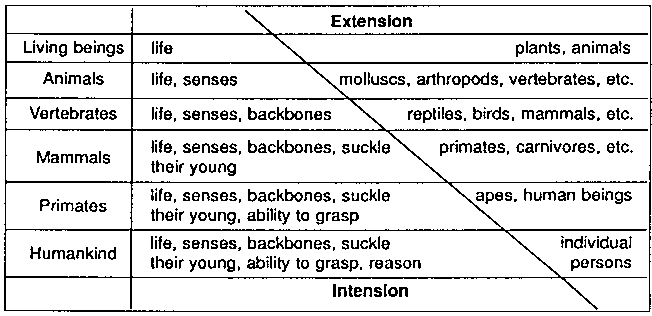
Fig. 10-1: Intension and Extension
When we compare any two concepts, the concept whose intension is broader and extension narrower is called "specific concept" (or subordinate concept), and the concept whose intension is narrower and extention broader is called "generic concept" (or superordinate concept). For example, when we compare the concept of vertebrate with the concept of reptile, the former is a generic concept in relationship to the latter; and the latter is a specific concept in relationship to the former. Also, when we compare the concept of animal with the concept of mollusk, the former is a generic concept, and the latter is a specific concept. If we repeat this operation over and over again, we will eventually reach the highest generic concept, beyond which no other concept can be traced. Such concepts are called "categories" (Fig. 10-2). In addition, the pure concepts that reason has by nature (rather than through experience) are also called categories. These categories vary from philosopher to philosopher. The reason is that the most important fundamental concepts in each thought system are considered categories. Accordingly, the meaning of categories vary from philosopher to philosopher.
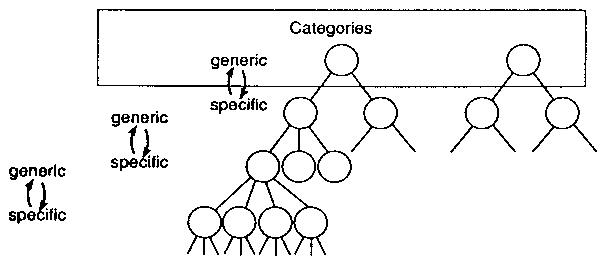
Fig. 10-2. Progressive Series Reaching up to Categories
Aristotle was the first philosopher to establish categories. He set up the following ten categories, taking clues from grammar:
i) substance
ii) quantity
iii) quality
iv) relation
v) place
vi) time
vii) position
viii) condition
ix) action
x) passivity
In the modern age, Kant established 12 categories, which were mentioned in "Epistemology."
3. Judgment
a) What is judgment?
An assertion of something about a certain object is called a Judgment." Logically, a judgment is an affirmation or denial of a relation among certain concepts. When expressed in language, a judgment is called a proposition.
A judgment consists of the three elements of subject, predicate, and copula. The object to which a thinking is directed is the subject; the predicate describes its content; and the copula connects the two. Generally, the subject is expressed as 'S', predicate as 'P', and copula as a judgement is formulated as "S-P."
b) Kinds of Judgment
As for the kinds of judgment, the twelve forms of judgment proposed by Kant are still employed in formal logic today. (Based on these forms of judgment, Kant derived his twelve categories.) Kant's twelve forms of judgment are as follows:
Quantity
Universal judgment: Every S is P.
Particular judgment: Some S is P.
Singular judgment: This S is P.
Quality
Affirmative judgment: S is P.
Negative judgment: S is not-P.
Infinite judgment: S is not-P.
Relation Categorical Judgment: S is P.
Hypothetical Judgment: If A is B, C is D
Disjunctive judgment: A is either B or C
Modality Problematic judgment: S may be P.
Assertoric judgment: S is in fact P.
Apodeictic judgment: S must be P.
c) Basic Form of Judgment
Of the above forms of judgment, the most basic is the categorical .judgment. If the universal and particular forms of judgment concerning quantity, and the affirmative and negative forms of judgment concerning quality are combined with the categorical judgment, the following four kinds of judgment can be obtained:
Universal Affirmative judgment: Universal Negative judgment: Particular Affirmative judgment: Particular Negative judgment:
Every S is a P. (A)
No S is a P. (E)
Some S is a P. (I)
Some S is not a P. (O)
The codes of A, E, I and 0 derive from the first two vowels of the Latin words affirmo ("affirm" A, I) and nego ("negate" E, O).
d) Distributed and Undistributed Terms
When making a categorical judgment, one must examine the relationship between the extension of the subject and that of the predicate. When a term applies to the proposition throughout its entire extension, that term is said to be "distributed." When the term applies to only a part of its extension, that term is said to be .undistributed."
For example, in the universal affirmative judgment "Every man (S) is an animal (P)" judgment A), the subject is distributed while the predicate is undistributed (Fig. 10-3). In other words, the term ,man' applies to the proposition "every man is an animal," throughout its entire extension, but the same is not true about the term animal.
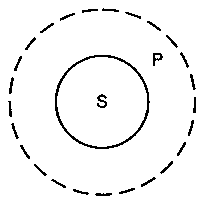
Fig. 10-3. Universal Affirmative judgment
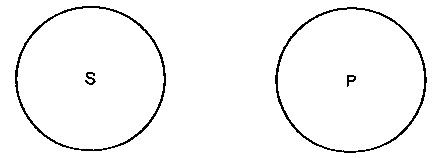
Fig. 10-4: Universal Negative judgment
In the universal negative judgment (judgment E) "No man is a plant," both subject and predicate are distributed (Fig. 10-4).
4. Inference
Inference refers to the process of reasoning whereby a proposition is derived from one or more propositions. The propositions which are already known are called "premises," and the proposition derived from them is called "conclusion." In this process, there are deductive inference and inductive inferences. Let us first deal with deductive inferences. When there is only one proposition, which is used as the premise, the inference is called direct inference." When there are two or more propositions as the premise, it is called an "indirect inference." Indirect inference will be introduced here.
When a conclusion is derived from two premises, we have a "syllogism," which can be categorical, hypothetical, disjunctive, or dilemma. The following is an example of a categorical syllogism:
Man is mortal. (major premise)
Socrates is a man. (minor premise)
Therefore, Socrates is mortal. (conclusion)
Here, of the three concepts ("Socrates," "man" and "mortal"), "mortal" has the greatest extension; therefore, it is called the "major term." Next, "Socrates" has the smallest in extension; therefore, it is called the "minor term." The extension of "man" is between the two; therefore, it is called the "middle term." If we label the major term as P, the minor term as S, and the middle term as M, the above example can be indicated as:
M is P. S is M. Therefore, S is P.
Between the two premises, the one containing P is called the .major premise," and the one containing S is called the "minor premise."
5. Induction and Analogy
a)Induction
The method by which one attempts to reach a general assertion from a number of observed particular facts is called inductive inference, or induction. It is regarded as an application of the syllogism. The following is an example of induction:
Horses, dogs, chickens, and cows are mortal. Horses, dogs, chickens, and cows are animals. Therefore, all animals are mortal.
This syllogism makes the mistake of the minor term being unduly distributed (the fallacy of illicit minor); still such inductive inferences are possible in natural science because of the "principle of uniformity in nature" and the "law of causality." The former means that all phenomena in the natural world have the same form, and the latter means that there are always cause and effect in natural phenomena.
b) Analogy
Analogy refers to the inference through which, based on similarities, other particular phenomena are inferred from known particular phenomena. This is regarded as a kind of induction. For example, the following is an analogy:
For the existence of living beings, water, air, appropriate temperature, and so on, are required.
On Mars there are water, air, appropriate temperature, and so on. Therefore, there probably exist living beings on Mars. Because this syllogism makes the mistake of an undistributed middle concept (fallacy of undistributed middle), the conclusion has merely the value of probability. But if the middle concept is distributed (that is, if all the necessary conditions for the existence of living beings are given), the conclusion becomes certain.
B. Hegel's Logic
1. The Characteristic of Hegel's Logic
Hegel's logic deals with the development of God's thinking, prior to the creation of the world, and is called heavenly logic. 2 However, unlike formal logic, it does not merely deal with the formal laws of thought. Although it holds itself to be the development of God's thinking, it attempts to deal with the most universal definitions and laws of reality.
2. Outline of Hegel's Logic
Hegel's logic consists of three branches, namely, the Doctrine of Being, the Doctrine of Essence, and the Doctrine of Notion. These three branches are each subdivided, such that the Doctrine of Being consists of Quality, Quantity, and Measure; the Doctrine of Essence consists of Essence, Appearance, and Actuality; and the Doctrine of Notion consists of Subjective Notion, Objective Notion and the Idea, and these are each, further subdivided. For example, Quality in the Doctrine of Being consists of Being, Determinate Being, and Being-for-Itself, and Being further consists of Being, Nothing, and Becoming.
The starting point of the development of Hegel's logic is the dialectic of Being-Nothing-Becoming. After passing through these three stages, Being moves on to Determinate Being. This Determinate Being has three further stages, and after passing through them, the Determinate Being moves on to Being-for-Self. Being-for-Self has three additional stages, and when they are gone through, it moves on to Quantity. Quantity moves on to Measure by passing through its own three stages, and when Measure has passed through its three stages, the theory concerning Being comes to an end.
Next is the theory concerning Essence. Hegel's logic moves from Essence to Appearance, and from Appearance to Actuality. Then comes the theory concerning the Notion. Notion moves from subjective Notion to Objective Notion, and from Objective Notion to the Idea. Within the Idea, there are three stages, namely, Life, Cognition, and the Absolute Idea. The Absolute Idea is the final destination in the development within logic.
Then the world of logic or the world of Idea negate itself, in order to realize itself truly, and moves on to the realm of Nature. According to Hegel, Idea moves on to become external to itself, in other words, Nature is the self-alienation of Idea, the negative of Idea, and Idea in the form of otherness. There are three stages of Mechanics, Physics and Organics in the realm of Nature.
Furthermore, Idea, which externalizes itself by negating itself, returns to its original self by further negating the negation. Idea as having recovered itself through human being is Spirit. Spirit passes through the three stages of Subjective Spirit, Objective Spirit, and Absolute Spirit. The Absolute Spirit stands at the highest point in the development of Spirit. The Absolute Spirit develops itself by passing through the three stages of Art, Religion, and Philosophy. The above description of Hegel's system can be illustrated in the following diagram (Fig. 10-5).
3. The Dialectic of Being-Nothing-Becoming
Hegel's logic, starting with Being, deals with the process of reaching the Absolute Idea. In this section, I will examine the initial dialectic of Being-Nothing-Becoming in the Doctrine of Being, because this portion constitutes the core of Hegel's logic.
Hegel's logic starts with Being. 3 Being means simply that which exists, but this is the most abstract of all concepts, and is an entirely indeterminate, empty thought. Therefore, lie says it is negative, namely, Nothing. For Hegel, Being and Nothing are both empty concepts, and there is little distinction between the two. 4
Next, Hegel says that the unity of Being and Nothing is Becoming. Both Being and Nothing are empty abstractions, but Becoming, which is the unity of the two opposites, is the first concrete thought. 5
With this logic of Being-Nothing-Becoming as the basis, the logics of thesis-antithesis-synthesis, affirmation-negation-negation of negation, etc., which are usually regarded as Hegel's method, came to be established.
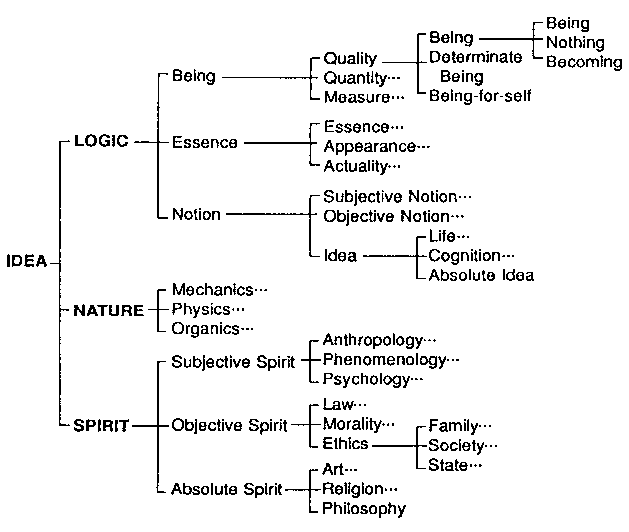
Fig. 10-5: Hegel's system
4. Determinate Being
Having examined Being-Nothing-Becoming, we move on to the examination of the Determinate Being. Determinate Being is Being with a certain form, Being considered concretely. While Being means simply to that which exists, Determinate Being means that which is something. Moving from Being-Nothing-Becoming to Determinate Being, in short, means moving from the abstract to the concrete. Becoming is a contradiction containing Being and Nothing within itself, and through this contradiction, Becoming transcends itself to become Determinate Being.
In this way, Determinate Being is a definite Being, a qualified Being. This determinateness of Determinate Being was called Quality by Hegel. However, even though we may say determinate, what is considered here is simple determination.
The determination that makes Being a Determinate Being implies the affirmative content of something, and at the same time, it implies limitation. Therefore, the quality that makes something what it is, is reality, when seen from the affirmative aspect of something, and at the same time it is negation when seen from the aspect of not being other thing. Therefore, in Determinate Being, reality and negation, or affirmation and negation, are united. Next, Determinate Being proceeds to Being-for-Self. Being-for-Self refers to the Being that is not related to another thing, nor changes into another thing, but stays as itself in every way.
5. Being-Essence-Notion
In the Doctrine of Being, starting from an analysis of what it is to exist, Hegel discussed the logic of change, or the logic of generation and disappearance. Next, the Doctrine of Being proceeds to the Doctrine of Essence. Here, the unchangeable aspect within things and the interconnectedness among all things are discussed. Next, it proceeds to the Doctrine of the Notion as the unity of the Doctrine of Being and the Doctrine of Essence. Here, the fact that things do not cease to be themselves while changing into other beings-that is, self-development-is discussed. The driving force of this development is the notion and life.
Why then can one say that God's thinking proceeded in the way of Being-Essence-Notion? One can understand this if he or she watches the process of his or her cognition as lie or she perceives things from externally to internally, lie says. In the case of perceiving a flower, for example, we first perceive the existence of the flower phenomenally. Next, we perceive the essence of the flower. Then, the notion of the flower is formed, in which the existence of the flower and the essence of the flower are united.
6. Logic-Nature-Spirit
As mentioned before, nature according to Hegel, is the Idea in the form of otherness, or the Idea as self-alienated. Therefore, if Logic is made to be the thesis, then Philosophy of Nature becomes the antithesis. Next, nature regains consciousness and freedom through the human being and becomes Spirit. Accordingly, the Philosophy of Spirit becomes the synthesis.
The natural world, also, performs the dialectical development of thesis-antithesis-synthesis, that is, the three stages of Mechanics, Physics, and Organics. This does not mean, however, that nature itself develops, but rather, this is the process through which the Idea behind the natural world manifests itself. First, the concept of force appears; next, the concept of physical phenomena; and then, the concept of living beings, lie says.
Finally, the human being appears, and the Spirit develops itself through humankind. This development takes place in the three stages of Subjective Spirit, Objective Spirit, and Absolute Spirit. Subjective Spirit refers to the spirit of the individual; Objective Spirit refers to the socialized spirit, or the objectified spirit transcending the individual.
Objective Spirit has the three stages of Law, Morality, and Ethics. Law refers not to something systematized like the constitution of a state, but to elementary forms in human relationships, like a group of people. Next, man comes to respect the rights of others and to lead a moral life. However, there are still many subjective aspects (individual aspects) there. Thus, ethics appears as the norms that everyone should communally observe. The first stage in ethics is the family. In the family, the members are linked with one another through love, and there is freedom there. However, in the stage of civil society, the interests of individuals conflict with one another, and freedom becomes restricted. Thus, the state, which integrates the family and civil society, appears. Hegel considered that the Idea would manifest itself fully through the state. The state in which the Idea is actualized is the rational state. Human freedom will be fully actualized in that state.
Finally, there appears the Absolute Spirit. The Absolute Spirit manifests itself through the three stages of art, religion, and philosophy. When it comes to the stage of philosophy, the Idea regains itself. The dialectical movement of the Idea returns to the origin in this way. Nature appears; the human being appears; the state appears; art, religion, and philosophy appear; and finally Idea returns to the perfect Idea (God). By accomplishing this return, the entire process of development comes to an end (Fig. 10-6).6
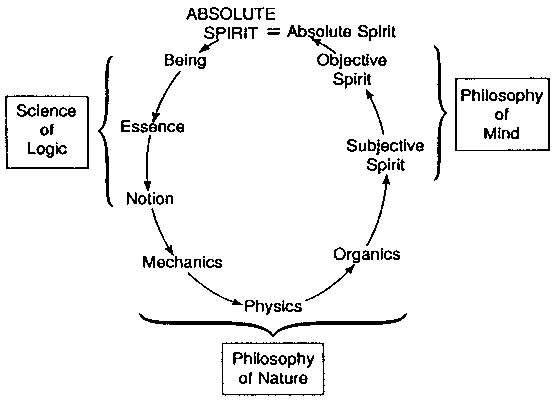
Fig. 10-6: The Returning Nature of Hegel's Dialectic
C. Dialectical Logic (Marxist Logic)
According to Hegel, the Idea manifest itself as nature in the clothing of matter; therefore, objective reality is the Idea. Marx, however, asserted that objective reality is matter, and that ideas (concepts) are merely the reflections of the material world on human consciousness. Yet Marx accepted, without change, Hegel's dialectic of thesis-antithesis-synthesis, and asserted that it is in fact the form of material development. Accordingly, in opposition to Hegel's "idealistic dialectic," Marx's dialectic is called "materialist dialectic."
The logic established in accordance with the materialist dialectic is dialectical logic. Its original characteristic is its opposition to formal logic, especially to the law of identity and the law of contradiction. 7 That is because, according to dialectical logic, in order for things to develop, A should be A and at the same time it should be not-A; and because the laws of thought should be the reflection of the material development of things. Marxists assumed that the forms and laws of thinking advocated by formal logic belong to the superstructure and have a class nature, and that they should reject them and create a new dialectical logic, in opposition to formal logic. 8 However, if formal logic was to be rejected, then one would inevitably run into a difficulty: without formal logic, it is impossible to conduct coherent and correct thinking.
Therefore, in 1950, Stalin published a paper entitled "Marxism and Problems of Linguistics," expressing that language does not belong to the superstructure nor does it have a class nature. With this thesis as the starting point, a series of discussions took place in the Soviet Union from 1950 to 1951 on the subject of how to evaluate formal logic. From those discussions, the conclusion was reached that the forms and laws of formal logic do not belong to the superstructure and do not have a class nature. It was also decided that, .while formal logic deals with elementary laws and forms of thinking, dialectical logic is a higher logic concerning the laws of development of objective reality and of thinking, which is the reflection of objective reality." 9
Yet, the logic based on materialist dialectic, namely, dialectical logic, makes only basic assertions. As a matter of fact, it has not been systematized as of yet. 10
D. Symbolic Logic
Symbolic logic, which is a development of formal logic, is an attempt accurately to research the correct method of judgment by using mathematical symbols. Symbolic logic contrasts with formal logic in important ways. In formal logic, the subject matter is the relationship of implication between terms, that is, the relationship of implication between the subject and the predicate in a proposition. In contrast, symbolic logic focuses on the connection between terms, or between propositions, and its subject-matter is the study of the laws of thought through the use of mathematical symbols.
The five basic forms of connection between propositions are as follow (where p and q are two propositions):

Fig 10-a
Through the combination of these five basic forms, any complicated deductive inference can be accurately expressed. For example, the basic laws of formal logic, namely, the law of identity, law of contradiction, and law of the excluded middle, can be symbolized as follows:

Fig. 10-b
Philosophers proposed great thought systems, but the question is whether or not their logical constructions are correct. In order to ascertain their correctness, we need to use mathematical symbols and make calculations. Symbolic logic came into being from such a point of view.
E. Transcendental
Kant's logic is called transcendental logic. Concerning the question of how objective knowledge can be obtained, Kant considered that objective knowledge can be obtained by thinking, through the forms of thought (forms of understanding), about the sensory content gained through the forms of intuition.
Kant divided the way of judgment into four types: quantity, quality, relation, and mode. Further, lie divided each of these into three kinds, establishing twelve forms of judgment. Based upon these forms, he established twelve forms of thought, or twelve categories. A category is the most basic framework through which we think. Categories are also called a priori concepts.
Ordinary logic, following Aristotle's formal logic, has dealt with the general forms and laws of thought, without considering the object of thought. Kant's logic, however, was epistemological logic, aiming to verify the knowledge concerning the object.
Download entire page and pages related to it in ZIP format
Table of Contents
Information
Tparents Home